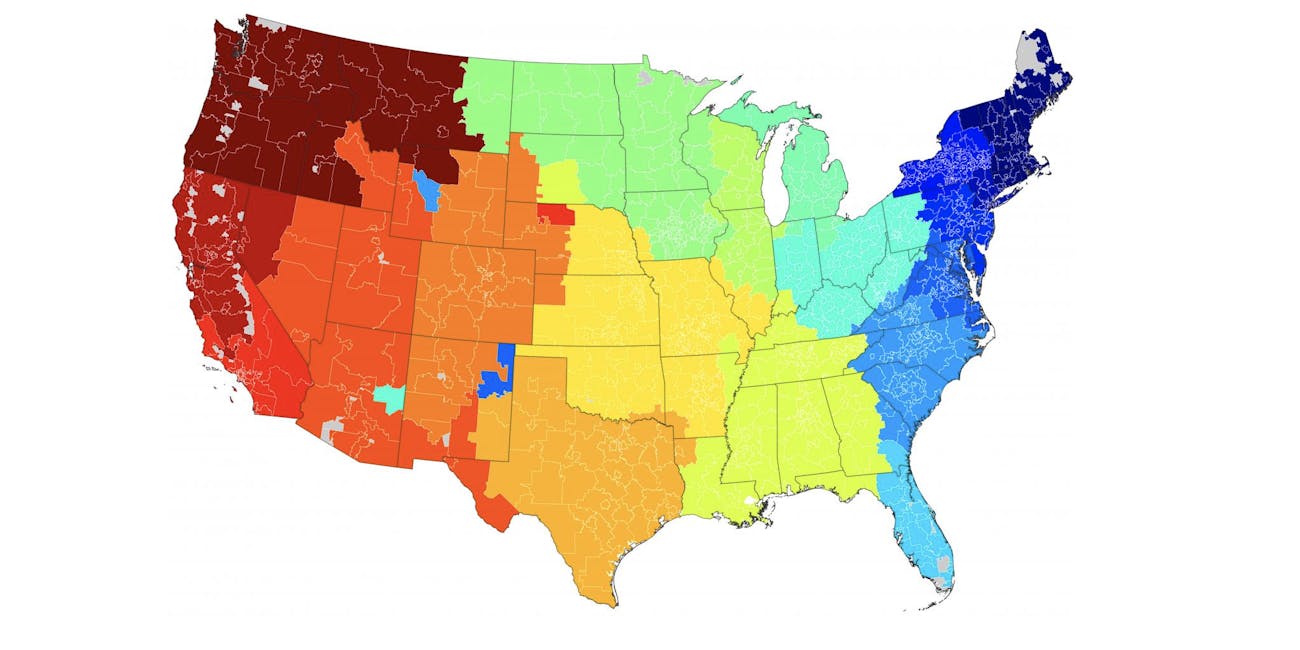
The wide pool of candidates accessible during online dating can feel overwhelmingly large. With the ability to message candidates from sea to shining sea, the perfect person may be just a DM away even if that person lives in the next state or county. But an analysis published Tuesday in Sociological Science reveals that even if that ultra-compatible human is out there, there’s a limit to how far we will go for love.
In this paper, University of Michigan researchers Mark Newman, Ph.D., a professor of information science, and Elizabeth Bruch, Ph.D., an associate professor of sociology, report that the most powerful driver of online romance is still distance when you look at national-level data. When Newman analyzed 15 million online dating DMs, he found that the country self-organized itself into 19 regions where people tend to pursue online relationships with one another. If you were to redraw the map of the United States according to how far people are willing to go to consider striking up a relationship online, you would get this map.

“It was a little surprising, at least to me, how perfectly the geographic regions follow accepted divisions of the country,” Newman tells Inverse. “For instance, in many cases they follow state boundaries.”
How Far Is Too Far?
Newman’s 19 regions were generated by an algorithm that analyzes reciprocated messages on a “popular” but unnamed online dating site. Reciprocated messages, as opposed to unanswered DMs, are intended to signal actual romantic interest, the authors explain. Potential candidates outside these regions, for most of the daters in their sample, just seemed too far away to pursue connections with. Most of the dating subregions align well with the traditional American sense of regional pride. For instance, the New England region includes Maine, Massachusetts, and Rhode Island, and the Pacific Northwest region covers Oregon, Washington, and parts of Idaho and Montana. But it’s not an exact match by region or state. Pennsylvania is split right down the middle, with half of daters preferring to converse with partners on the east coast, and others leaning toward the midwest. Many of the subregions are wider than you might imagine. For instance, online daters in central regions of Missouri, Arkansas, Kansas, and Oklahoma all seem perfectly happy to respond to messages in neighbouring states a distance that encompasses hundreds of miles total. But in other regions, people are a bit pickier. In some cases, Newman noticed that daters limited their choices largely by state. Daters in Northern California tend to reciprocate to in-state messages rather than give someone from nearby Oregon a shot. Texans, too, tend to prefer in-state dating. They are far more likely to reply to another Texan even one who lives miles away than someone just across the state border in Oklahoma.“There’s no practical reason why they should do this. If you live near a state boundary, it’s quite possible that there are plenty of potential dating partners within easy travel distance in the next state over,” says Newman. “But apparently there is little such inter-state dating going on.”Newman and Bruch add that geography-based dating makes sense, especially since the preliminary goal of dating sites is to plan a face-to-face meetup. To that end, a dater in New York is more likely to respond to a message from someone nearby and ignore someone from California. But even on a local level, the extreme examples seen in Texas, for instance, hint at a possible psychological barrier to dating across state lines.“Perhaps there is a psychological barrier there?” He asks. “Perhaps dating someone who lives in a different state feels like going too far, even if they are only a mile down the road?”
Dating in the Same City
But as strange as the lack of inter-state dating is, Newman and Bruch’s paper is also dedicated to illuminating how people choose potential partners when the distance is no object. By using the online dating messages from people in Boston, New York, Chicago, and Seattle, he found that people also self-organize within cities. Specifically into four age-related submarkets. These groups are roughly grouped by decade. People in their early 20s made up the first group, people in their late 20s made up the second group, the third group was populated by people in their late 30s, and the fourth was made up of people 40 and older.